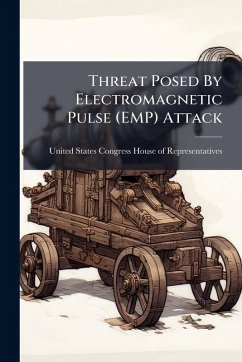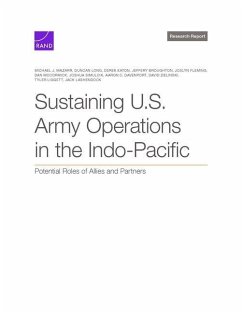
Electromagnetic Pulse Threats to U.S. Expeditionary Operations in 2010
Versandkostenfrei!
Versandfertig in über 4 Wochen
14,99 €
inkl. MwSt.
Weitere Ausgaben:

PAYBACK Punkte
7 °P sammeln!
US military forces depend on electronic systems and information dominance to produce overwhelming combat power. Indeed, defense leaders are calling for development of a network-centric force to rapidly deploy and conduct decisive operations in the future security environment. Unfortunately, the information revolution embraced by the military has a dark side-it introduces a potentially catastrophic vulnerability. Electronics, the foundation of the network-centric force, are extremely vulnerable to a rapidly proliferating class of arms--electromagnetic pulse (EMP) weapons. EMP weapons come in ma...
US military forces depend on electronic systems and information dominance to produce overwhelming combat power. Indeed, defense leaders are calling for development of a network-centric force to rapidly deploy and conduct decisive operations in the future security environment. Unfortunately, the information revolution embraced by the military has a dark side-it introduces a potentially catastrophic vulnerability. Electronics, the foundation of the network-centric force, are extremely vulnerable to a rapidly proliferating class of arms--electromagnetic pulse (EMP) weapons. EMP weapons come in many forms and levels of sophistication. Some can be built from readily available parts for a few hundred dollars, some require extensive technological expertise and research facilities, and the most effective require both the capability to build a nuclear device and the ability to launch it with a missile. While recent literature has proclaimed that the sky is falling in regard to US vulnerability to EMP, the truth is that not all EMP weapons produce catastrophic effects on all systems. The goal of this paper is to classify near-term EMP threats to US expeditionary operations in terms of their probability of use, lethal range, systems they affect, and their potential users to identify high-payoff protective measures. The paper makes specific recommendations on cost effective solutions to address the most likely and most dangerous threats. This work has been selected by scholars as being culturally important, and is part of the knowledge base of civilization as we know it. This work was reproduced from the original artifact, and remains as true to the original work as possible. Therefore, you will see the original copyright references, library stamps (as most of these works have been housed in our most important libraries around the world), and other notations in the work. This work is in the public domain in the United States of America, and possibly other nations. Within the United States, you may freely copy and distribute this work, as no entity (individual or corporate) has a copyright on the body of the work. As a reproduction of a historical artifact, this work may contain missing or blurred pages, poor pictures, errant marks, etc. Scholars believe, and we concur, that this work is important enough to be preserved, reproduced, and made generally available to the public. We appreciate your support of the preservation process, and thank you for being an important part of keeping this knowledge alive and relevant.












